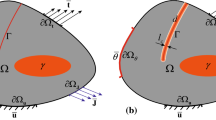Abstract
We analyze the stochastic nature of various critical parameters responsible for the brittle fracture of nuclear pressure vessel steels. It is shown that the critical stress of brittle fracture Sc governing the process of propagation of shear microcracks can be regarded (with sufficient accuracy) as a deterministic parameter. At the same time, the critical parameter controlling the process of initiation of microcracks should be regarded as stochastic. On the basis of the performed analysis, we modify our local criterion of brittle fracture proposed earlier to the case of probabilistic statement of the problem.
Similar content being viewed by others
References
F. M. Beremin, “A local criterion for cleavage fracture of a nuclear pressure vessel steel,”Met. Trans.,14A, 2277–2287 (1983).
J. F. Knott,Fundamentals of Fracture Mechanics, London, Butterworths (1973).
B. Z. Margolin and V. A. Shvetsova, “Criterion of brittle fracture: physicomechanical approach,”Probl. Prochn., No. 2, 3–16 (1992).
B. Z. Margolin, V. A. Shvetsova, and G. P. Karzov, “Brittle fracture of nuclear pressure vessel steels. Part 1. Local criterion for cleavage fracture,”Int. J. Pres. Ves. Piping,72, 73–87 (1997).
B. Z. Margolin, G. P. Karzov, and V. A. Shvetsova, “Brittle fracture of nuclear pressure vessel steels. Part 2. Prediction of fracture toughness,”Int. J. Pres. Ves. Piping,72, 89–96 (1997).
N. N. Davidenkov,Dynamic Testing of Materials [in Russian], ONTI, Moscow (1936).
A. Ya. Krasovskii,Brittleness of Metals at Low Temperatures [in Russian], Naukova Dumka, Kiev (1980).
L. A. Kopel’man,Resistance of Welded Joints to Brittle Fracture [in Russian], Mashinostroenie, Leningrad (1978).
G. J. Hahn and S. Shapiro,Statistical Models in Engineering, Wiley, New York (1967).
V. V. Rybin,High Plastic Strains in Metals [in Russian], Metallurgiya, Moscow (1986).
J. V. Fernandes and J. -H. Schmit, “Dislocation microstructures in steel during deep drawing,”Phil. Mag.,4A (6), 841–870 (1983).
V. Ya. Baranov,Influence of Structural Inhomogeneities and External Loading Factors on the Shear Resistance of Structural Steels [in Russian], Author’s Abstract of the Candidate Degree Thesis (Technical Sciences), Kiev (1986).
A. N. Cottrel, “Theory of brittle fracture in steel and similar metals,”Trans. AIME,212, 192–203 (1958).
K. Wallin, T. Saario, and K. Törrönen, “Statistical model for carbide induced brittle fracture in steel,”Met. Sci.,18, 13–16 (1984).
C. J. McMahon and M. Cohen, “Initiation of cleavage in polycrystalline iron,”Acta Met.,13, 591–604 (1965).
T. C. Lindley and C. E. Richards, “The effect of quench-aging on the cleavage fracture of low-carbon iron,”Met. Sci.,4, No. 5, 81–84 (1970).
W. A. Weibull, “A statistical theory of strength of materials,”Roy. Swed. Inst. Eng. Res.,151, 5–45 (1939).
A. Seeger, “Mechanism of sliding and hardening in face-centered cubic and hexagonal close packed metals,” in: M. V. Klassen-Neklyudova and V. L. Indenbom, eds.,Dislocations and Mechanical Properties of Crystals [in Russian], Inostr. Lit., Moscow (1960), pp. 179–268.
R. Berner and H. Kronmüller,Plastische Verformung von Einkristallen, Springer-Verlag, Berlin (1965).
V. D. Yaroshevich and D. G. Ryvkina, “Influence of the structure on the activating parameters of the process of deformation of Armco iron at low temperatures,”Fiz. Met. Metalloved.,31, No. 6, 1293–1298 (1971).
V. I. Kostylev and V. Z. Margolin, “Solution of an elastoplastic problem of dynamic fracture mechanics by the finite-element method,”Probl. Prochn., No. 7, 6–12 (1990).
G.P. Karzov, B. T. Timofeev, and V. P. Leonov,Welded Pressure Vessels: Strength and Durability [in Russian], Mashinostroenie, Leningrad (1982).
Yu. F. Balandin, I. V. Gorynin, Yu. I. Zvezdin, et al.,Structural Materials of Nuclear Power Plants [in Russian], Énergoatomizdat, Moscow (1984).
G. P. Karzov, B. Z. Margolin, and V. A. Shvetsova,Physicomechanical Simulation of Fracture Processes [in Russian], Politekhnika, St. Petersburg (1993).
B. Z. Margolin, G. P. Karzov, V. A. Shvetsova, and V. I. Kostylev, “Modelling for transcrystalline and intercrystalline fracture by void nucleation and growth,”Fatigue Fract. Eng. Mater. Struct., 21, No. 2, 123–138 (1998).
Additional information
TsNII KM “Prometei,” St. Petersburg, Russia. Translated from Problemy Prochnosti, No. 1, pp. 5–20, January–February, 1999.
Rights and permissions
About this article
Cite this article
Margolin, B.Z., Gulenko, A.G. & Shvetsova, V.A. Probabilistic prediction of the crack resistance of nuclear pressure vessel steels on the basis of a local approach. Part 1. Strength Mater 31, 1–12 (1999). https://doi.org/10.1007/BF02509734
Received:
Issue Date:
DOI: https://doi.org/10.1007/BF02509734




